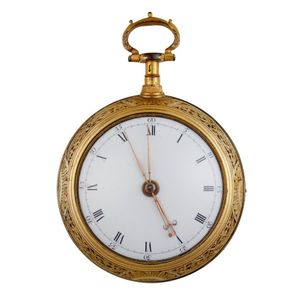Edward Tomlin Royal Exchange Gilt Metal Clock Watch
You must be a subscriber, and be logged in to view price and dealer details.
Subscribe Now to view actual auction price for this item
When you subscribe, you have the option of setting the currency in which to display prices to $Au, $US, $NZ or Stg.
- Movement - The technical name for the workings of a clock or watch, and does not include the dial or case.
- Fusee - The fusee movement was used in clocks and pocket watches from the mid 17th century. The fusee is a cone shaped drum within the works that is linked to the barrel of the spring, usually by a length of chain.
As the mainspring loses its tension over time, the cone shaped barrel compensates for this by increasing the tension, by pulling the mainspring tighter, thus ensuring the time remains constant.
Use of the fusee in clocks was superseded by the "going barrel" in the mid 19th century and for pocket watches at the beginning of the 19th century.
The fusee continued to be used in marine chronometers until the 1970s. - Circa - A Latin term meaning 'about', often used in the antique trade to give an approximate date for the piece, usually considered to be five years on either side of the circa year. Thus, circa 1900 means the piece was made about 1900, probably between 1895 and 1905. The expression is sometimes abbreviated to c.1900.
This item has been included into following indexes:
Visually similar items

James Green London An 18ct gold pair cased quarter repeating watch mvt 6605 English circa 1770, english fusee cylinder movement signed and numbered James Green, London no 6605, pierced and engraved balance cock, diamond endstone, cylindrical pillars, white

A large silver plated cased chronograph pocket watch, key wind movement, white enamel dial with Roman numerals, repairs to enamel

Rolled gold pocket watch. Appears operational but May need service. Enamel dial chipped.

Lady's 14ct gold Longines open face pocket watch, white enamel dial with Arabic numerals, subsidiary seconds, stem wind and set on a 15 jewel plate movement no. 1300239, signed Longines, momogrammed rear cover. Size 29 mm.
